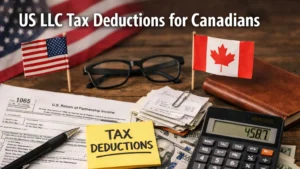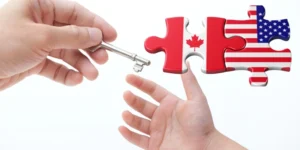Double taxation—paying tax twice on the same income—hurts Canadians earning abroad, expats, non-residents with Canadian income, and small business owners in cross-border trade. In 2025, avoiding this burden is essential. Did you know 70% of Canadian small businesses with foreign income overpay taxes due to double taxation?
This guide explains what it is, its impact on individuals and corporations, and how to use CRA rules, foreign tax credits, and treaties to protect your money. Plus, discover practical ways to structure income and reduce tax risks. Stay with SAL Accounting to make your tax strategy simple and save more.
Quick Takeaways
- Double taxation happens when two countries tax the same income, like foreign wages or profits.
- Cut Canadian taxes with a Foreign Tax Credit (CRA) using Form T2209 for amounts paid abroad.
- Use tax treaties, like the Canada-U.S. agreement, to avoid or reduce double taxes.
- Organize income—freelancers invoice through a Canadian entity, corporations set up foreign branches.
- Track all foreign income and taxes to support credit and treaty claims.
- Unused foreign tax credits can be carried back 3 years and forward 10 years.
What Is Double Taxation in Canada? How Does It Affect You?
Double taxation happens when two countries tax the same income, like foreign wages or business profits. Canada taxes residents on all their income, wherever it’s earned, while other countries tax income earned within their borders. Without relief, you pay twice, losing a lot of money.
Who’s Affected?
Here’s who faces double taxation and how it impacts them:
- Individuals: For individuals, double taxation often strikes when you earn foreign income, like salaries, dividends, or rental payments.
Example: Priya, a Toronto resident, owns a rental property in the U.S. She pays $10,000 (20%) in U.S. taxes on $50,000 of rental income. Canada taxes it too, adding $13,000 (26%) without a credit, costing her an extra $10,000
- Corporations: Corporations face similar challenges.
Example: A Toronto tech startup sells software in the U.S., paying 21% U.S. federal corporate tax and 26.5% in Canada on the same profits. In 2023, Canadians paid over $10 billion in foreign taxes, showing how widespread this issue is.
Double taxation reduces your savings or business growth. For individuals, it means less money to spend or save; for companies, it limits funds for expansion. Knowing how to avoid it in 2025 protects your financial future.
Read More: “Understanding Taxes for US Citizens Working Remotely for Canadian Companies”
Avoid Double Taxation: CRA Rules for Residents vs. Non-Residents
The Canada Revenue Agency (CRA) has clear rules on who pays what. Your tax residency status determines your obligations. You can also learn about “CRA My Business Account” in our previous blog post.
What Income Do Residents Report?
As a Canadian resident, you must report all income—domestic and foreign—on your tax return. This includes:
- Employment or freelance earnings from abroad
- Investment income, like dividends or interest
- Rental income from overseas properties
Example: Mark, a Vancouver consultant, worked three months in the U.S., earning $30,000 and paying U.S. taxes. Since he’s a Canadian resident (living here over 183 days), he must report that $30,000 to the CRA. Without relief, he risks double taxation on that income.
Important: If you hold foreign property worth over $100,000, you must also file Form T1135 with your return.
What Income Do Non-Residents Report?
Non-residents pay tax only on income from Canadian sources, like:
- Wages for work done in Canada
- Rental income from Canadian properties
- Capital gains from selling Canadian real estate
Example: A U.S. investor selling a Calgary condo owes 25% withholding tax on the gain in Canada, reducible to 15% by filing Form NR301 under the Canada-U.S. treaty. Their home country might tax the gain too, creating a double taxation risk. Our small business tax specialists can help navigate these complex situations.
How Does the CRA Decide Your Residency?
Residency isn’t just about how long you stay in Canada. The CRA checks if you stay over 183 days, which usually makes you a resident, but this isn’t automatic. They also look at residential ties like owning a home, having family here, maintaining Canadian bank accounts or a driver’s license, and whether you plan to stay or leave.
In a real case, a Canadian who lived abroad but kept a house and family in Toronto was deemed a resident, owing taxes on global income. Unsure? Use this checklist:
☐ Do you own or rent a home in Canada?
☐ Are your spouse or kids here?
☐ How many days did you spend in Canada in 2025?
Tie-Breaker Rules: If two countries claim you as a resident, tax treaties step in. Provide documents like utility bills or a lease to the CRA to prove your U.S. or Canadian residency, helping you avoid double taxation. The Canada-U.S. treaty, for instance, uses factors like your permanent home or closer personal ties to assign residency.
3 Strategies to Avoid Double Taxation in Canada
You can protect your income from double taxation in Canada with smart strategies. Here are three key tools to keep more of your money, especially when dealing with U.S. income.
1. Foreign Tax Credits
If you paid taxes in the U.S., a Foreign Tax Credit (CRA) reduces your Canadian tax bill dollar-for-dollar, up to a limit.
Steps to Claim an FTC
- File Form T2209 with your T1 return.
- Convert U.S. taxes to CAD using the Bank of Canada’s exchange rate.
- Calculate the credit: for non-business income like dividends, claim up to 15% of the income or the actual foreign tax paid, whichever is less; for business income, claim the full tax paid, capped at your Canadian tax on that foreign income.
Example: Sarah earned $50,000 U.S. rental income and paid $10,000 U.S. tax. Her total income is $100,000, and Canadian tax is $20,000.
- Maximum credit allowed: $20,000 × ($50,000 ÷ $100,000) = $10,000
- Foreign tax paid: $10,000 CAD
- Foreign Tax Credit = Lesser of $10,000 or $10,000 = $10,000
Here is a comparison of the Foreign Tax Credit and Deduction presented in a table below.
| Aspect | Foreign Tax Credit | Deduction |
|---|---|---|
| What It Does | Lowers your Canadian tax by the U.S. tax paid, up to a limit. | Reduces your taxable income by the U.S. tax paid. |
| Tax Savings | Bigger savings; cuts tax directly (e.g., $10,000 credit = $10,000 less tax). | Smaller savings; depends on your tax rate (e.g., $10,000 at 26% = $2,600 less tax). |
| Complexity | Needs Form T2209, currency conversion, and proof like U.S. tax slips. | Easier; just claimed as a deduction on your return. |
| Best For | Most cases, especially high U.S. tax payments. | Rare cases where credits don’t apply or no treaty exists. |
Pro tip: When claiming a Foreign Tax Credit, don’t mess up converting U.S. taxes to Canadian dollars—use the Bank of Canada’s daily exchange rate for the payment date, not the annual average. Keep U.S. tax slips as proof and maintain detailed records beyond just tax slips for proper backup. Don’t claim penalties or interest, as only foreign income tax counts toward your credit.
2. Tax Treaties
The Canada-U.S. tax treaty helps avoid double taxation by setting rules on which country taxes what. It can exempt income (e.g., a Canadian’s U.S. salary might be tax-free in Canada), cut withholding rates (e.g., 15% instead of 30% on U.S. dividends), or settle residency disputes. You can check our withholding tax guide for more details.
How Treaties Are Built
Negotiated bilaterally, treaties include provisions like:
- Article 4: Residency tie-breakers
- Article 10-12: Dividends, interest, royalties
- Article 15: Employment income
Treaties also include beneficial ownership rules, meaning you must be the true owner of income to claim benefits, and anti-abuse provisions to prevent treaty shopping. Check the CRA’s treaty list for specifics. The Canada-U.S. treaty, one of the most used, saved Canadians millions in 2023.
3. Structuring Income Streams
Smart planning cuts your tax exposure, especially for Canada-U.S. income streams.
Freelancers
Freelancers can invoice U.S. clients via a Canadian business to simplify taxes and use PayPal to track U.S. withholding. If U.S. earnings exceed $100,000, consider incorporating to save taxes.
Example: Mark, a Vancouver consultant, billed his $30,000 U.S. job through a Canadian sole proprietorship, making his Foreign Tax Credit claim straightforward.
Corporations
Corporations can set up a U.S. branch to localize profits and use transfer pricing to split income fairly between Canada and the U.S. Plan your estate to avoid double taxation at death, as $2 million in shares could face 72% tax without a strategy.
Pro tip: Advanced strategies like foreign affiliate rules and FAPI rules help manage taxes for overseas businesses. Also Advance Pricing Agreements set fair pricing for cross-border deals to avoid double taxation. Get professional international tax planning to optimize your structure.
Example: A Calgary oil company with U.S. operations used a branch to cut Canadian taxes on U.S. profits, saving 15% each year.
Read More: “Global Minimum Tax: How Pillar Two Tax Affects Canada–U.S. Cross-Border Payments”
2025 Tips to Avoid Double Taxation in Canada
Protect your income from double taxation in 2025 with these simple steps. Follow these practical tips to navigate Canada-U.S. tax rules and keep more of your money.
1. Track Your Income and Taxes
Record all U.S. income and taxes paid to support your Foreign Tax Credit claims. This keeps your records clean and avoids CRA issues.
- Use software like QuickBooks for easy tracking.
- Save U.S. tax slips, like W-2 or 1099 forms.
Document exact dates of tax payments and use Bank of Canada daily rates for all conversions. Keep detailed records beyond just tax slips for proper backup.
Learn more about reporting Canadian income on US returns.
2. File Taxes Correctly and Early
Use the right forms to claim Foreign Tax Credits and avoid double taxation on U.S. income.
- File Form T1 (individuals) or T2 (corporations) with your return.
- Include Form T2209 to claim credits for U.S. taxes paid.
- Include Form T1135 if you hold foreign property over $100,000, and provincial foreign tax credit forms where applicable.
File early to secure credits, speed up refunds, and avoid missing treaty benefits.
3. Stay Updated on Tax Rules
Keep up with changes to the Canada-U.S. tax treaty or CRA rules in 2025 to maximize your tax savings. Check the CRA website or subscribe to tax newsletters for updates.
4. Use APAs for Businesses
If your business operates in the U.S., get an Advance Pricing Agreement (APA) to set fair transfer pricing. This prevents audits and reduces double taxation risks.
5. Hire a Tax Professional
Get expert help to navigate complex Canada-U.S. tax rules. We can ensure you claim all credits and treaty benefits to avoid overpaying. Contact our US tax accountants and get all the answers you need.
| Case Study: Ottawa Software Guy’s $12,000 Tax Mess The Problem: Kevin runs a small software company in Ottawa and made $320,000 from U.S. clients last year. His American customers kept taking $32,000 in taxes off his payments because they thought they had to. Then Canada wanted another $85,000. Kevin was freaking out, thinking he’d have to sell his house to pay both bills. What We Did: We sorted out the paperwork to get Kevin credit for what his U.S. clients already took, and helped him fix his contracts so this wouldn’t happen again. We also got his cross-border stuff properly documented. The Result: Kevin only had to pay $73,000 to Canada, saving him $12,000 right away. His clients stopped taking taxes out of his payments, and now he’s working with three new U.S. companies without worrying about the tax headaches. |
Conclusion
Double taxation doesn’t have to shrink your wallet in 2025. By mastering CRA rules, claiming foreign tax credits, and using tax treaties like the Canada-U.S. agreement, you can stop paying twice. Freelancers and corporations can structure income to minimize risk, while residents and non-residents alike benefit from proactive planning.
Questions? Contact our cross-border tax experts at SAL Accounting for a free call!
FAQ: Your Double Taxation Questions Answered
Report it to the CRA and claim a foreign tax credit or treaty relief.
A reduction in Canadian tax for foreign taxes paid, claimed via Form T2209.
Yes, over 90, including with the U.S., U.K., and Germany.
Yes, all global income if you’re a tax resident.
They assign taxing rights and reduce rates on specific income.
Treaties use tie-breaker rules to pick one.
By time in Canada (183+ days), ties, and intent.
Yes, via treaties or credits if taxed abroad.
You can carry them back 3 years and forward 10 years. Plan your income timing to maximize their use.
Use the Bank of Canada’s daily exchange rate for the date the foreign tax was paid, not the annual average rate.






